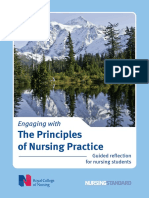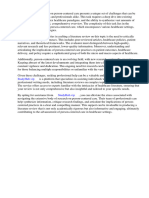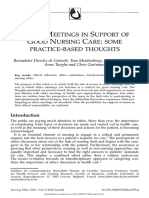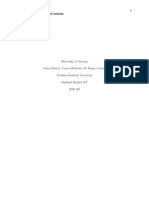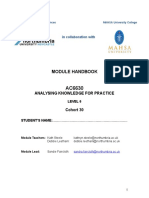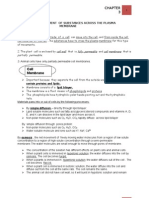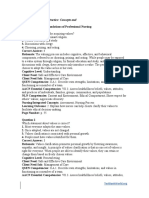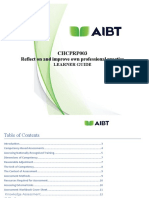05 PracticeFW AppendixA
05 PracticeFW AppendixA
Uploaded by
nurhanim ckCopyright:
Available Formats
05 PracticeFW AppendixA
05 PracticeFW AppendixA
Uploaded by
nurhanim ckOriginal Description:
Original Title
Copyright
Available Formats
Share this document
Did you find this document useful?
Is this content inappropriate?
Copyright:
Available Formats
05 PracticeFW AppendixA
05 PracticeFW AppendixA
Uploaded by
nurhanim ckCopyright:
Available Formats
Canadian Nurse Practitioner Initiative
A Conceptual Model for Nurse Practitioner Practice
Prepared for the Canadian Nurse Practitioner Initiative (CNPI)
Rob Calnan, Manager, Practice and Evaluation
By
ROBINSON VOLLMAN INC.
Ardene Robinson Vollman, RN, PhD
Ruth Martin-Misener, RN, NP, PhD(c)
December, 2005
In this document, we propose a model
for nurse practitioner (NP) practice
within the context of advanced practice
nursing1. The model depicts practice as
a registered nurse (a nurse practitioner)
providing care and service (advanced
practice nursing) to a client (individual,
family, aggregate, or community), in a
network of social and cultural contexts,
over time.
The CNA has a framework for advanced
nursing practice. It describes an
advanced level of nursing practice that
maximizes the use of in depth nursing
knowledge and skill in meeting the
health needs of clients (1, p.1).
Advanced nursing practice is an
umbrella term used to describe the roles
of NPs (2) and clinical nurse specialists
(CNS) (3). Advanced practice nursing is
used to describe the whole field of
advanced nursing practice (4).
Advanced practice nurses exhibit
1
The March 2005 Colloquium report advised the
term advanced practice nursing not be
capitalized or abbreviated because it is not a title
protected by regulation.
several characteristics and are able to
demonstrate competencies in five key
areas (clinical competence, leadership,
collaboration, research, and change
agency) (1).
In March, 2005 several experts met in a
two-day colloquium to debate key
questions leading to NP practice model
development (5). In preparation for the
colloquium, we asked Is a new model
for NP practice needed; is there nothing
available in the current literature we can
use to describe NP practice for the
CNPI? In response, we reviewed a
number of models of advanced practice
nursing and nurse practitioner practice
models and found each wanting, in
different ways (6). Few models were
Canadian and, as a consequence, did not
respect our unique healthcare system,
context, identity, strengths and
challenges. Therefore, we opted to
create a model of NP practice based on
the literature commissioned for the
CNPI.
Conceptual Model For Nurse Practitioner Practice In Canada
Canadian Nurse Practitioner Initiative
In colloquium discussions, the NP was
affirmed as an advanced practice
nursing role, and a recommendation
was put forward that urged CNA to
revise its framework to reflect the
broader conceptualizations of advanced
practice nursing. Further, the
colloquium identified key differences in
NP and CNS roles and recommended
discussions continue in conjunction
with key stakeholders to achieve clarity.
The colloquium began the task of
describing unique qualities and
characteristics of NP practice:
1. The primary focus of NPs and what
makes them different from other
nursing roles is the legislated
authority for autonomous diagnosis
of disease, prescribing, and
treatment;
2. The focus of the NP role is direct
clinical care with clients that
emphasizes health promotion and
prevention, early detection and
treatment of episodic, acute, and
chronic health problems; and
3. What is unique about the services
offered by NPs derives from
blending highly developed clinical
diagnostic and therapeutic
knowledge, skills, and abilities
within a nursing framework that
emphasizes holism, health
promotion and partnerships with
individuals and families, as well as
communities.
Over the remaining months of the
CNPI, exemplars and stories of NP
practice were collected and analysed to
further develop understanding of the
NP role.
Practical deliberation (7) forms the
foundation for our conceptualization of
NP practice. To deliberate means to
think carefully and attentively;
reflect(8). Deliberation is purposeful
and intentional. By the term practical
we mean that the concepts and
descriptions we use are derived from
and are applicable to actual real-life
events and descriptions of NP practice,
the decisions that need to be made, and
the outcomes of those choices. In
contrast, theoretical problems are more
abstract and further way from real
experiences. The model we propose is
consistent with the metaparadigm of
nursing2, but has been derived by a
different process deliberation.
In deliberating about practice, we find
Schwabs four commonplaces to be
instructive: the nurse practitioner (NP),
the client, the discipline; and context (7).
Further we add Ben Peretz fifth
commonplace (time) to connote the
novice to expert conceptualization
inherent in the evolution of practice of
the discipline of nursing (9).
What is a commonplace? A
commonplace is an ordinary, natural,
everyday element that serves to
organise thinking about topics. Using
the commonplaces in deliberations
allows full assessment of situations and
helps to uncover and seriously consider
enough alternatives. To ignore any of
the commonplaces, or privilege some
over others, would bring an inadequate
assessment to the deliberations. A
Person, health, environment, nurse.
Conceptual Model For Nurse Practitioner Practice In Canada
Canadian Nurse Practitioner Initiative
systematic consideration of all five
commonplaces is essential.
In this sense, to think about NP practice,
one needs to examine the NP, his/her
unique subject matter or discipline
(advanced practice nursing), people and
or communities served by the NP
(client), and the places, and nature of
those places, where NP practice occurs.
Since we appreciate the notion that
upon graduation, nurses are not expert
at nursing, we include the commonplace
of time to allow deliberation of the
process by which, over time, the NP
moves from novice NP practice to
expert NP practice. Time is included in
each of the commonplaces to indicate
how, over time, knowledge levels
expand with respect to clients and the
complexity of their needs; the body of
knowledge of the discipline; and
complex systems and contexts that
affect the practice environment.
In the first section of this document, we
will present the approach we used for
model design. Then, we will detail the
elements of the NP Practice Model in
light of the vision of the healthy client
and the five commonplaces. We show
how the model is situated within
scholarly inquiry and evidence-based
practice, the Canadian healthcare
system, and the norms and values of the
broader Canadian society.
Approach to model design
Using the key concepts discussed above,
a draft model was proposed by the
facilitators (Robinson Vollman &
Martin-Misener) at a colloquium held in
March 2005 comprising key experts in
NP practice that had been brought
together to provide advice and direction
to the Manager, Practice and Evaluation,
CNPI. We incorporated feedback
provided by these experts into a second
draft model that received feedback on a
teleconference. This report captures the
input and reflections on the model
(Figure 1) through the colloquium and
feedback process. In a practice
workshop held in June 2005 with a
group of NPs, administrators, regulators
and health care providers from other
disciplines, we obtained further input
on practice configurations and
facilitators and barriers to NP practice
that further informed the model.
In the next sections, we discuss each
component of the model separately.
The order of presentation begins with
the discipline because this is where the
subject matter content knowledge is
held and where regulatory and
educational institutions address
standards and licensure issues. The
client commonplace follows because the
client base determines the focus of NP
practice while the context determines the
practice pattern arrangement within
which the NP works. Next we present
the NP commonplace, illustrating its
dependence on each of the other
commonplaces that create its
foundation. The time commonplace
completes the discussion and illustrates
how the NP moves from novice to
expert, the context from micro- to multisystem, the client from individuals to
families and communities, and the
Conceptual Model For Nurse Practitioner Practice In Canada
Canadian Nurse Practitioner Initiative
discipline from a narrow focus to
breadth of focus.
Vision of health
First, we see health at the centre of the
model. The vision of the healthy client
(individual, family, group or aggregate,
community, and/or population) or, in
other words, the outcome of nurse
practitioner practice is defined here.
What is health? According to the
Ottawa Charter for Health Promotion
(10) health is defined as: a state of
complete physical, mental and social
well-being, an individual or group must
be able to identify and to realize
aspirations, to satisfy needs, and to
change or cope with the environment.
Health is, therefore, seen as a resource
for everyday life, not the objective of
living. Health is a positive concept
emphasizing social and personal
resources, as well as physical
capacities.
In order to achieve this vision of health,
and therefore a healthy client, the five
commonplaces need to act separately
but in concert towards health as the
central goal of NP practice. In the next
section, we will describe each commonplace. Each commonplace is viewed as a
separate entity, not as intersecting or
interacting with others or the external
environments in which practice is
situated. Later, if evidence warrants,
Figure 1: A conceptual model for Nurse Practitioner practice in Canada
Conceptual Model For Nurse Practitioner Practice In Canada
Canadian Nurse Practitioner Initiative
The Discipline commonplace
2. promoting, protecting,
maintaining, rehabilitating or
supporting health;
3. preventing illness or injury; and
4. supporting end of life care.
This commonplace contains the body of
knowledge of the discipline of nursing
and self-regulatory aspects for the
profession of nursing. What does the
discipline of nursing offer in terms of
understanding the content (body of
knowledge) associated with NP
practice? As a result of the efforts of
the Canadian Nurse Practitioner
Initiative (CNPI) Practice Component,
the definition of the NP has been
recommended to read as follows:
Advanced practice nursing is an
umbrella term that describes an
advanced level of nursing practice that
maximizes the use of in-depth nursing
knowledge and skill in meeting the
health needs of clients (individuals,
families, groups, populations, or entire
communities)(1). In this way, advanced
practice nursing extends the boundaries
of nursing knowledge and contributes
to the development and advancement of
the profession.
Nurse practitioners are experienced
registered nurses with additional
education that have achieved the
competencies required for nurse
practitioner registration or licensure in
a province or territory. Using an
evidence-based, holistic approach that
emphasizes health promotion and
partnership development, nurse
practitioners complement, rather than
replace other health care providers.
Nurse practitioners, as advanced
practice nurses, blend their in-depth
knowledge of nursing theory and
practice with their legal authority and
autonomy to order and interpret
diagnostic tests, prescribe pharmaceuticals, medical devices and other
therapies, and perform procedures.
They carry out these actions for the
purposes of:
1. diagnosing and/or treating acute
and chronic disease;
Advanced practice nursing is not a title
and therefore should not be capitalized
or abbreviated. It occurs within the full
scope of registered nursing practice, and
a nurse working at an advanced practice
level exemplifies certain characteristics
listed in the CNA Framework (1). In
addition, advanced practice nursing
comprises a set of core competencies.
researchers can speculate on or demonstrate the interactions among the
commonplaces.
As we deliberate the discipline
commonplace, it is important to note
that this is where the specific subject
matter knowledge is held, skills are
articulated, and where competencies
that are licensed are located. Standards also fit in this commonplace as
specific targets and ethics of NP work.
Acts governing NP practice need to be
examined in light of their impacts or
effects on other relevant professional
Acts that either facilitate or impede NP
Conceptual Model For Nurse Practitioner Practice In Canada
Canadian Nurse Practitioner Initiative
practice. If, for instance, pharmacists,
diagnostic imaging technicians, laboratory technicians, and/or others are
prohibited by their Acts from acting on
prescriptions or requisitions from NPs,
the nursing profession needs to step in
and advocate for NPs. In this case, the
Federal, provincial and territorial (FPT)
Nursing Associations and/or Colleges
represent the discipline commonplace.
Standards of NP performance are set by
the discipline (profession), even though
the employer may enact them.
Outcomes or performance standards
(11) of NP practice include improved
access to quality cost-effective care;
timely access; addressing service gaps
(p. 28); and patients satisfaction with
NPs ability to care for them in primary
care practices, including time spent and
quality of information provided (p. 29).
The discipline is where NPs go to learn
more about the situations that they face,
current knowledge and research, the
emerging skills needed, and the politics,
economics, and values that impact
practice. Often the discipline partners
are involved in creating and disseminating new knowledge through
educational institutions, professional
journals, researchers, and continuing
education sessions and conferences,
offering CE credits and/or certificates
for achievement.
process for this commonplace. The
nature of the client, health status, health
literacy and knowledge of self-care,
aspirations for health outcomes,
anxieties, capacities, and barriers in
place to healthy outcomes these are
key topics for deliberation. It is
important that this deliberation be
undertaken by direct involvement with
the client group, or with the
participation of the client group in the
deliberations.
Who is the client? What are the client
characteristics? The CNA Framework (1)
depicts clients as individuals, families,
groups, aggregates, populations, and
communities. We can further suggest
that clients are recipients of care, come
from diverse backgrounds, span a large
age range, have a variety of health needs
and coping skills, and live within social
contexts. Additional detail will be
added to this conceptualization based
on the narratives we will obtain from
practising NPs.
The Context commonplace
The Client commonplace
The context refers to the immediate
milieu in which NP practice occurs. In
what sorts of settings do NPs carry out
their work? How do these and other
contexts influence the NP? Consider
these influences not just from the NP
perspective but also from client and coworker points of view.
The description of the specific client
base and the characteristics, needs,
desires, and capacities to which a NP
must respond is part of the deliberation
Deliberations regarding this
commonplace must include the various
milieus in which practice takes place
and which the outcomes of care are
Conceptual Model For Nurse Practitioner Practice In Canada
Canadian Nurse Practitioner Initiative
brought to bear. The relevant contexts
are manifold, nested one within the
other, and include the setting and
organizational structure in which NPs
interact with clients and other
professional colleagues. What are their
relations to each other? What is the
structure of authority? What is the
relationship of this practice grouping
with other practice groupings or
healthcare professionals and/or
systems?
Literature reviews prepared for the
CNPI reveal a number of contextual
descriptions. First, the client/public
lacks understanding of the role of the
NP and the benefits to the public of that
role.
Second, there is lack of understanding
of the role by physicians who have not
practised with an NP; those that have,
are more clear about the role and its
contributions to the healthcare system.
Physicians underscore this lack of
understanding by claiming to be
unhappy with NP role preparation (i.e.,
knowledge base). Further, they view
collaborative practice as timeconsuming, disruptive and potentially
deskilling for themselves. Physicians
fear they are being asked to change their
practice behaviours to accommodate NP
practice, creating tension and slowing
the pace of change to collaborative
practice models. These factors are
affecting physician-NP relations at the
front lines, relations at the Association
levels, and creating tensions around
professional legislation and regulation
in many provinces. The economic and
financial barriers are significant barriers
to NP implementation.
In the third place, there is concern
around remuneration and medico-legal
liability as they relate to interprofessional practice. Physicians are
anxious about their liability for care
provided to patients in the context of
collaboration with an NP. Some NPs
have concerns about their liability for
delays in patient care that occur as a
result of system-related barriers to NP
practice, for example, when lab results
are sent to the physician instead of the
NP.
Other contextual factors are played out
at the employer agency level with
respect to practice pattern
arrangements. At the organizational
level, who should manage NPs and how
is unclear in many settings; job
descriptions may not be clear; and
performance benchmarks for quality
care have not been determined. Settingspecific policies (11) regarding coverage
of week-end shifts, statutory holidays,
sick time need to be developed, and
continuing education, remuneration,
and other employment issues need to be
more standardized (p. 54).
There are many practice pattern
arrangements in which NPs provide
health services. The literature, including
Canadian research (12-16), suggests that
some of the key concepts in these
arrangements or models are:
The nature, needs and priorities of
the client;
The focus and scope of services
provided by the NP;
Conceptual Model For Nurse Practitioner Practice In Canada
Canadian Nurse Practitioner Initiative
The context, including geography,
availability of resources, roles of
other health care team members,
employer policies and supports;
Legal and regulatory requirements;
How collaboration, consultation and
referrals occur internally in the
setting among team members and
externally to other health care
providers, organizations or levels of
care;
The availability of information
systems such as electronic health
records, telehealth, internet, etc.; and
Models for funding and
remuneration.
The following are some of the models of
care now being used in Canada; it is
evident that the variety and scope of the
settings and the nature of the
populations served are diverse:
Geographical settings remote;
rural; urban
Institutional settings community
health centres; long term care
centres; community hospitals;
ambulance transport; nursing
stations; family practice offices;
home care services; student health
services; mental health settings;
correctional facilities; academic
practices; emergency rooms; among
others.
Populations all ages primary care;
lower socioeconomic groups;
aboriginal populations; people with
chronic diseases; students;
employees; among others.
Practice configurations solo
(independent) practice;
interdisciplinary teams; legislated
collaborative agreements;
consultative models; interprofessional practice; among others.
The future may offer fewer health
human resources to meet the increasing
demands for care from elders who are
living longer with chronic conditions,
aging in place, and have need for
technology and support in the
community. In addressing the
context commonplace, NP practice
pattern arrangements need to be
assessed to ensure the NP role is
optimized without unnecessary
barriers/restriction placed on it.
The NP commonplace
For the deliberations of this commonplace, we must understand the
expectations of nurse practitioners as a
population what they know, what
they have experience in doing, what
skills they hold, how flexible they are in
terms of learning new ways of carrying
out their nurse practitioner skills, their
values, attitudes, and capacities. We
need to understand how they are likely
to interact with colleagues, with clients,
with one another. We need to understand what they have learned in their
NP programs and what they bring with
them in terms of nursing theoretical
approaches, biases, and what issues
they champion.
The role of NP has suffered from a lack
of clarity so that the various federal,
provincial and territorial jurisdictions
have had to write their own definitions,
determine respective scopes of practice,
Conceptual Model For Nurse Practitioner Practice In Canada
Canadian Nurse Practitioner Initiative
and set educational requirements for
role preparation and performance
standards that differentiate NPs from
other advanced practice nursing roles.
This makes stipulating national-level
characteristics for NP a difficult task.
The basic preparation for the NP is
founded upon a set of agreed-upon panCanadian core competencies that all
NPs will demonstrate (17). These 78 core
competency statements describe the
minimum requirements with respect to
the integrated knowledge,
skills, judgment and attributes required
of an entry-level nurse practitioner to
practise safely and ethically in
a designated role and setting, regardless
of client populations or practice
environments. There are four categories
of NP core competencies that build
upon the foundation of RN competence:
health assessment and diagnosis; health
care management and
therapeutic intervention; health
promotion and prevention of illness,
injury and complications; and professional role and responsibility.
According to the literature provided by
the CNPI (11, 19-21) and our own
experience and reflections, NPs have the
ability to practice in a variety of settings;
with multi-faceted clinical role skills;
often in ambiguous and/or complex
situations where they need to use
complex reasoning, critical thinking and
analysis to inform practice, judgement,
and decision-making. Hence, the NP
must be an independent learner who is
continually seeking new understandings
through a variety of means to reflect
critically on practice. He/she also has
well-developed communication,
negotiation and conflict resolution skills
that fosters the ability to demonstrate
leadership in planning, implementing
and evaluating interventions; provide
care to a variety of clients (individuals,
families, aggregates, populations, and
communities) by engaging clients in
care. It is important for NPs to work at
multiple systems levels to get to the root
of the problems that surface.
The Time commonplace
Ben Peretz (9) suggested a fifth
commonplace that offers a means of
incorporating the novice to expert
practice component we acknowledged
previously. A newly graduated NP will
not be expert in the competencies, but
over time (and with experience,
mentorship, and continuous learning) to
fully appreciate the NP role, he/she will
develop expertise in all areas (22) .
Similarly, over time and with
appropriate inquiry we increase the
body of knowledge of the discipline;
improve our understanding and ability
to work within and influence multiple
system contexts; and gain a breadth of
understanding of our client population
(from individuals, families, groups,
aggregates, populations and
communities) as we interact with it over
time and history.
Conceptual Model For Nurse Practitioner Practice In Canada
Canadian Nurse Practitioner Initiative
Evidence-based practice and the
external environment
Nurse practitioners practice within a
professional context that demands that
practice be based on research and
evidence. Hence, the core model is
encircled by permeable lines that
comprise society and evidence-based
professional practice and inquiry. This
means that greater societal norms
impact on practice and that there is
impact of society on each of the
commonplaces. Further, inquiry and
evaluation are necessary conditions to
ensure quality and coordination among
deliberations and action.
The Canadian healthcare system
There have been several initiatives,
commissions, and reports in place that
have and are affecting the role of
professionals practising in the health
system across the country. Each of these
professions is regulated in different
ways, from different perspectives, and
for different purposes. This larger
environment (and perhaps others, such
as the education and social welfare
systems) has an impact on how NPs are
situated in the practice arena. Any
discussion of practice therefore must
consider these elements since this larger
system will govern the emphases of
funding and practice for the next
decades in terms of primary health care,
long term care, acute diagnostic and
tertiary critical care service, response to
crises, and the like.
10
CNPI literature reviewed revealed the
following healthcare system and
environmental factors:
Having no national legislative
regulatory framework has allowed
inconsistencies to develop across
jurisdictions. Legitimacy of the role
and public safety are the key reasons
why a national approach is
imperative.
Without sustainable funding,
appropriate reimbursement models,
and quality assurance/improvement
models, health human resource
planners cannot successfully
interpret or respond to supply
demand issues in current times of
scarce resources.
Cultural and historical bases for
healthcare funding and delivery in
Canada, attitudes about and by the
professions, and lack of
understanding by the public are
hampering healthcare reform and
the emergence of an appropriate
place for NP practice.
What does this model offer?
There are authors (6, 19) that have done
good critical overviews of existing
conceptual models/frameworks related
to advanced practice nursing, three of
which are specific to the NP role. The
Schuler (23) framework, for instance, is
very complex and focused on what NPs
do in clinical encounters. As such it is
very focused on individual encounters,
has a lifestyle emphasis, and does not
acknowledge the NP role with
communities or groups. The circle of
caring model by Dunphy & Winland-
Conceptual Model For Nurse Practitioner Practice In Canada
Canadian Nurse Practitioner Initiative
Brown (24) tries to demonstrate how the
knowledge and skills from nursing and
medicine might come together in the NP
role. A third model that is of specific
interest to the NP role is the domains of
NP practice identified by Fenton &
Bryczynski (25). Hamric's model of
advance practice nursing (26) has some
merit for consideration as we develop
the NP Practice Framework for the
CNPI. Notwithstanding this scholarly
work contributed by the above authors,
none represents the Canadian context.
Therefore development of a Canadian
model will offer a significant
contribution to the discipline in our
country.
11
Summary
This promising model is in early stages
of conceptualization. With the vision of
the healthy client in a central role, the
four commonplaces can be separately
deliberated, time can be considered as a
fifth commonplace. Evidence-based NP
practice can be situated in the broader
social context within the Canadian
health care system, with the overarching
goal being achieving the vision of
health.
Conceptual Model For Nurse Practitioner Practice In Canada
Canadian Nurse Practitioner Initiative
12
REFERENCES
1) Canadian Nurses Association (2002). Advanced nursing practice: A national framework.
Ottawa: Author.
2) Canadian Nurses Association (2003). Position Statement: The nurse practitioner. Ottawa:
Author.
3) Canadian Nurses Association (2003). Clinical nurse specialist. Ottawa: Author.
4) Bryant-Lukosius, D., Dicensoa, A., Browne, G. & Pinelli, J. (2004). Advanced practice
nursing roles: development, impelementation and evalution. Journal of Advanced Nursing,
48 (5), 519-529.
5) Robinson Vollman, A. & Martin Misener, R. (2005) Report of a colloquium on nurse
practitioner practice in Canada. [CNPI unpublished].
6) Spross, J.A. & Lawson, M.T. (2005). Conceptualizations of advanced practice Nursing. In
Hamric, A.B., Spross, J.A., & Hanson, C.M. (Eds). Advanced practice nursing: An
integrative approach, 3rd. Edition. St. Louis, MO: Elsevier Saunders; pp47-84.
7) Schwab, J.J. (1973). The practical 3: Translation into curriculum. School Review 81
(August 1973); 501-522.
8) Webster (1989). Encyclopaedic unabridged dictionary of the English language. Avenel
NJ: Gramercy Books.
9) Ben-Peretz, M. (1986). Time: The fifth commonplace in curricular deliberations. Paper
presented at the 67th Annual Meeting of the American Educational Research Association,
San Francisco, CA April 16-20).
10) World Health Organization (1986). The Ottawa Charter for Health Promotion. Geneva:
Author.
11) Tarrant F. (2005). Environmental scan of supports, barriers, and impediments to practice.
[CNPI unpublished].
12) IBM Business Consulting In. (2003). Report on the Integration of primary health care nurse
practitioners in the province of Ontario. Available at
http://www.health.gov.on.ca/english/public/pub/ministry_reports/nurseprac03/nursepra
c03_mn.html.
13) Ontario Medical Association (OMA) & Registered Nurses Association of Ontario
(RNAO) (2003). The RN(EC)-GP relationship: a good beginning. Toronto, ON: Goldfarb
Intelligence Marketing and Dave Health Care solutions. Available at
http://www.oma.org/pcomm/omarnaoreport2003.pdf
14) Goss Gilroy Management Consultants Inc. (2001). Report on the evaluation of
implementation of the role of NP, primary health care in Newfoundland and Labrador.
Newfoundland: Author.
15) Hanrahan, C., Way, C., Housser, J. & Applin, M. (2001). The nature of the
extended/expanded nursing role in Canada. Consultant Center for Nursing Studies and
the Institute for the Advancement of Public Policy. Authors.
16) MacLeod, M., Kulig, J., Stewart, N., Pitblado.(2004). Rural and Remote Nursing
Practice: Final Report to Canadian Health Services Research Foundation. Available at
http://www.ruralnursing.unbc.ca/pubandpresent.php
17) Dunn, K. & Nicklin, W. (1995). The status of advanced nursing roles in Canadian
teaching hospitals. Canadian Journal of Nursing Administration, Jan-Feb, 111-135
Conceptual Model For Nurse Practitioner Practice In Canada
Canadian Nurse Practitioner Initiative
13
18) Canadian Nurse Association (CNA), 2005. Canadian nurse practitioner core competency
framework. Ottawa: Author.
19) Fahey-Walsh, J. (2004). Advanced practice nursing and the primary health care nurse
practitioner: Title, scope and role. [CNPI unpublished].
20) Jones, L. & Way, D. (2004). Delivering primary health care to Canadians: Nurse
practitioners and physicians in collaboration. [CNPI unpublished].
21) Calnan, R. & Fahey-Walsh, J. (2005). Report on the initial consultations for the practice
22) component. [CNPI unpublished].
23) Brown, M.A. & Olshansky, E. (1998). Becoming a primary care nurse practitioner:
challenges of the initial year of practice. The Nurse Practitioner, 23(7), 46-66.
24) Shuler, P.A. & Davis, J.E. (1993). The Shuler nurse practitioner practice model: A
theoretical framework for nurse practitioner clinicians, educators, and researchers, Part 1.
Journal of the American Academy of Nurse Practitioners, 5, 11-18.
25) Dunphy, L.M. & Winland-Brown, J.E. (1998). The circle of caring: A transformative model
of advanced practice nursing. Clinical Excellence for Nurse practitioners, 2, 241-247.
26) Fenton, M.V. & Brykczynski, K.A. (1993). Qualitative distinctions and similarities in the
practice of clinical nurse specialists and nurse practitioners. Journal of Professional
Nursing, 9, 313-326.
27) Hamric, A.B., Spross, J.A., & Hanson, C.M. (2005). Advanced practice nursing: An
integrative Approach, 3rd Edition. St. Louis MO: Elsevier Saunders; 48-84.
28) Hamric, A.B. (2000). A definition of advanced practice nursing. In Hamric, A.B., Spross,
J.A., & Hanson, C.M. (Eds). Advanced practice nursing: An integrative Approach, 2nd
Edition. Philadelphia PA: WB Saunders; 53-74.
Conceptual Model For Nurse Practitioner Practice In Canada
You might also like
- Clinical Supervision HandbookDocument155 pagesClinical Supervision HandbookLiCruz89% (9)
- Paradigm Critique PaperDocument15 pagesParadigm Critique Papergkempf10No ratings yet
- Kawasaki DiseaseDocument22 pagesKawasaki DiseaseMax LocoNo ratings yet
- Concept Map of The Evolution of Nursing Science and TheoryDocument1 pageConcept Map of The Evolution of Nursing Science and TheoryEstelle Rhine100% (1)
- NURSING INFORMATICS Community Health ApplicationsDocument6 pagesNURSING INFORMATICS Community Health ApplicationsThirdy Aquino100% (2)
- Nursing Care ModelDocument7 pagesNursing Care ModelRobin Ravenel100% (1)
- Sample 2 GibbsDocument5 pagesSample 2 GibbsAhmed YusufNo ratings yet
- Framework, Scope and Trends in Nursing PracticeDocument36 pagesFramework, Scope and Trends in Nursing PracticeSubeena GulNo ratings yet
- DocumentbbbDocument4 pagesDocumentbbbMuhammad AamirNo ratings yet
- UNIT 1: Nursing As A Profession Lesson 1: Introduction: Intended Learning OutcomesDocument114 pagesUNIT 1: Nursing As A Profession Lesson 1: Introduction: Intended Learning OutcomesGrace Ramos67% (3)
- What Is Person-Centred Health Care A Literature ReviewDocument4 pagesWhat Is Person-Centred Health Care A Literature ReviewcmppcmwgfNo ratings yet
- Framework Trend and Scope of Nursing PracticeDocument28 pagesFramework Trend and Scope of Nursing PracticeShaells Joshi80% (5)
- Physiotherapist Specialised PracticeDocument5 pagesPhysiotherapist Specialised PracticeZainab Noor ShahidNo ratings yet
- Nursing Arts LO Module 4Document7 pagesNursing Arts LO Module 4AmberpersonNo ratings yet
- Theory Application PaperDocument13 pagesTheory Application Paperapi-295425485100% (1)
- Theoretical Basis of Community Health Nursing-1Document49 pagesTheoretical Basis of Community Health Nursing-1Sri WahyuniNo ratings yet
- Professionaldevelopmentplan ShefferDocument17 pagesProfessionaldevelopmentplan Shefferapi-235387260No ratings yet
- BACON ResearchDocument17 pagesBACON ResearchLianne BuensucesoNo ratings yet
- Relationship-Based Nursing Practice: Transitioning To A New Care Delivery Model in Maternity UnitsDocument10 pagesRelationship-Based Nursing Practice: Transitioning To A New Care Delivery Model in Maternity Unitsimas KurniawatyNo ratings yet
- CIF Razonamiento ClinicoDocument16 pagesCIF Razonamiento ClinicoDavid ParraNo ratings yet
- Gibbs Reflective Journal SampleDocument4 pagesGibbs Reflective Journal SampleCres Padua Quinzon100% (3)
- Literature Review Occupational Therapy and Primary Health CareDocument6 pagesLiterature Review Occupational Therapy and Primary Health Carec5r08vf70% (1)
- Nursing Theories - Four Ways of KnowingDocument5 pagesNursing Theories - Four Ways of KnowingAira Shayne MagbooNo ratings yet
- A Nursing TheoryDocument8 pagesA Nursing TheoryDennis Nabor Muñoz, RN,RMNo ratings yet
- The Principles of Nursing Practice: Engaging WithDocument16 pagesThe Principles of Nursing Practice: Engaging WithMaggieNo ratings yet
- Running Head: Nurse Administration Roles 1Document15 pagesRunning Head: Nurse Administration Roles 1Irungu MugiNo ratings yet
- Professional Practice in Nursing: A Framework: Francine GirardDocument8 pagesProfessional Practice in Nursing: A Framework: Francine GirardAmeng GosimNo ratings yet
- Notes BSC NSG 4th Yr Unit 4Document9 pagesNotes BSC NSG 4th Yr Unit 4Shenaya singhNo ratings yet
- Advanced Practice Nursing Leadership: A Global PerspectiveFrom EverandAdvanced Practice Nursing Leadership: A Global PerspectiveNo ratings yet
- Clinical Psychomotor Skills 7th Edition EbookDocument26 pagesClinical Psychomotor Skills 7th Edition EbooksmikopasNo ratings yet
- Lesson 2 in Theoretical Foundation of NursingDocument6 pagesLesson 2 in Theoretical Foundation of NursingAngelica Rigor ValdezNo ratings yet
- Module 1 Overview of The Nursing ProcessDocument6 pagesModule 1 Overview of The Nursing ProcessCocaineNo ratings yet
- Alternative Systems of MedicineDocument70 pagesAlternative Systems of MedicineRoselineTigga100% (1)
- Person Centered Care Literature ReviewDocument4 pagesPerson Centered Care Literature Reviewafdtaeczo100% (1)
- Nursing Process ReportDocument30 pagesNursing Process ReportJoanne CareahNo ratings yet
- 01 - Professional Nursing PracticeDocument40 pages01 - Professional Nursing PracticeElysabeth GoldsteinNo ratings yet
- Theoritical Foundation of NursingDocument66 pagesTheoritical Foundation of Nursingchakmaw gamingNo ratings yet
- National Nursing Core Competency Standards 2012: Brief HistoryDocument8 pagesNational Nursing Core Competency Standards 2012: Brief HistoryJasimahNo ratings yet
- Literature Review Occupational TherapyDocument5 pagesLiterature Review Occupational Therapyafdtorpqk100% (1)
- BACHELOR IN NURSING - Docx (Reflection)Document9 pagesBACHELOR IN NURSING - Docx (Reflection)siti husniNo ratings yet
- Nursing & Physiotherapy in UKDocument6 pagesNursing & Physiotherapy in UKMotilaldass100% (1)
- Ethical Challenges Faced by Health Care Facilities and Their StaffDocument14 pagesEthical Challenges Faced by Health Care Facilities and Their StaffAbirahNo ratings yet
- Application of Theory in Nursing ProcessDocument19 pagesApplication of Theory in Nursing ProcessCurly AngehNo ratings yet
- Nu708 Newbern S Module7Document5 pagesNu708 Newbern S Module7api-555348585No ratings yet
- Messier Nur4140 ProfessionalmeetingreflectionDocument4 pagesMessier Nur4140 Professionalmeetingreflectionapi-711019083No ratings yet
- Fundamental of NursingDocument993 pagesFundamental of NursingSyed BuRhan Ud-Din100% (5)
- Cuidados Paliativos, Ingles, Terapia Ocupacional PDFDocument41 pagesCuidados Paliativos, Ingles, Terapia Ocupacional PDFEsteban LlerenaNo ratings yet
- 10 1191@0969733002ne555oaDocument11 pages10 1191@0969733002ne555oamariana alvarezNo ratings yet
- 440 SelfassessDocument20 pages440 Selfassessapi-234511817No ratings yet
- Pamelaking694 2000 Words at 1.7Document10 pagesPamelaking694 2000 Words at 1.7Mian SalmanNo ratings yet
- Jayson NovellesDocument38 pagesJayson Novellesaronara dalampasiganNo ratings yet
- Florence Nightingale Defined Nursing Over 100 Years Ago AsDocument20 pagesFlorence Nightingale Defined Nursing Over 100 Years Ago AsJaya PriyaNo ratings yet
- AKIN OTIKO B O Quality Nursing Care in NigeriaThe Ideals Realities and ImplicationsDocument19 pagesAKIN OTIKO B O Quality Nursing Care in NigeriaThe Ideals Realities and ImplicationsUmar Farouq Mohammed GalibNo ratings yet
- End-Of-life Care Pathways and Nursing A Literature ReviewDocument5 pagesEnd-Of-life Care Pathways and Nursing A Literature Reviewea8r2tykNo ratings yet
- Nursing Models and Care Planning CCDocument26 pagesNursing Models and Care Planning CCangelica1971No ratings yet
- Health Sciences and NursingDocument9 pagesHealth Sciences and Nursingfraz afzalNo ratings yet
- Correctional Nursing: Scope and Standards of Practice, Third EditionFrom EverandCorrectional Nursing: Scope and Standards of Practice, Third EditionRating: 5 out of 5 stars5/5 (1)
- FINAL-PSYCHE Without TranscribeDocument42 pagesFINAL-PSYCHE Without TranscribeGino B. BulanaNo ratings yet
- Nursing Care Plan and Nightingale's Environmental TheoryDocument4 pagesNursing Care Plan and Nightingale's Environmental TheoryBALDOZA LEO FRANCO B.No ratings yet
- DNP 800 Philosophy of NursingDocument7 pagesDNP 800 Philosophy of Nursingapi-247844148No ratings yet
- Clinical Nurse Specialist Role and Practice: An International PerspectiveFrom EverandClinical Nurse Specialist Role and Practice: An International PerspectiveJanet S. FultonNo ratings yet
- Critical-Care Nurses’ Perceived Leadership Practices, Organizational Commitment, and Job Satisfaction: An Empirical Analysis of a Non-Profit HealthcareFrom EverandCritical-Care Nurses’ Perceived Leadership Practices, Organizational Commitment, and Job Satisfaction: An Empirical Analysis of a Non-Profit HealthcareNo ratings yet
- Albendazole 200 MG Tablet (Zentel)Document1 pageAlbendazole 200 MG Tablet (Zentel)nurhanim ckNo ratings yet
- Acyclovir 200 MG (Aciclovir)Document1 pageAcyclovir 200 MG (Aciclovir)nurhanim ckNo ratings yet
- Proposal FormDocument1 pageProposal Formnurhanim ckNo ratings yet
- AC6630 C30 HandbookDocument44 pagesAC6630 C30 Handbooknurhanim ckNo ratings yet
- 040323A Practical Approach To Promote Reflective Practice Within NursingDocument4 pages040323A Practical Approach To Promote Reflective Practice Within Nursingnurhanim ckNo ratings yet
- Normal Sinus Rhythm: 2 Dgree HeartDocument1 pageNormal Sinus Rhythm: 2 Dgree Heartnurhanim ckNo ratings yet
- Movement of Substances Across The Plasma MembraneDocument27 pagesMovement of Substances Across The Plasma Membranenurhanim ckNo ratings yet
- Report AppendicesDocument3 pagesReport Appendicesnurhanim ckNo ratings yet
- Vanessa Perez ResumeDocument2 pagesVanessa Perez Resumeapi-247302506No ratings yet
- Population Based NursingDocument17 pagesPopulation Based NursingNabila AfiliaNo ratings yet
- ch04 PDFDocument16 pagesch04 PDFJessica nonye100% (1)
- Ain Cover Letter AustraliaDocument8 pagesAin Cover Letter Australiavup0nemyj1n3100% (2)
- Starting An Intervention - Group 5-1Document4 pagesStarting An Intervention - Group 5-1Popi Bunga RopikohNo ratings yet
- Newman's Health As Expanding ConsciousnessDocument13 pagesNewman's Health As Expanding ConsciousnessKiki Hardiansyah SafitriNo ratings yet
- Community Health NursingDocument5 pagesCommunity Health NursingNida Villaseca SalesNo ratings yet
- Rubrics Perilight TherapyDocument1 pageRubrics Perilight TherapyPrinces Vench SanchezNo ratings yet
- Thera ComDocument8 pagesThera ComJonathan IbañezNo ratings yet
- CHN ReviewDocument407 pagesCHN Reviewshenric16100% (1)
- How To Make A Nursing Care PlanDocument2 pagesHow To Make A Nursing Care PlanBea Abigail BrocalNo ratings yet
- Aibt Chcprp003 Learner Workbook Ecec v1.0Document58 pagesAibt Chcprp003 Learner Workbook Ecec v1.0ks khalsaNo ratings yet
- Chain of Command ProcedureDocument7 pagesChain of Command ProceduresehrNo ratings yet
- Oleh: Septi Dewi Rachmawati: Jurusan Keperawatan Fakultas Kedokteran Universitas BrawijayaDocument26 pagesOleh: Septi Dewi Rachmawati: Jurusan Keperawatan Fakultas Kedokteran Universitas BrawijayaMegeon SeongNo ratings yet
- Interview Hospital Questions NursesDocument2 pagesInterview Hospital Questions NursesAmg Longinus0% (1)
- Sample Resumes For Nurses: Sample Resume I Erika L. NurseDocument4 pagesSample Resumes For Nurses: Sample Resume I Erika L. NurseAlwin Varghese TNo ratings yet
- Module 3 - Nursing Assessment in Family Nursing PracticeDocument7 pagesModule 3 - Nursing Assessment in Family Nursing PracticeRogedith DelaRosaNo ratings yet
- Course Content: A N Introduction To The OETDocument3 pagesCourse Content: A N Introduction To The OETKelvin KanengoniNo ratings yet
- Introduction To Nursing Research.22401551Document16 pagesIntroduction To Nursing Research.22401551Alphonse Elric0% (1)
- Vampire Dissertation TopicsDocument7 pagesVampire Dissertation TopicsCustomPaperServiceSingapore100% (1)
- Nursing As An Academic DisciplineDocument20 pagesNursing As An Academic DisciplineJules Antonette RNNo ratings yet
- 1 s2.0 S0020748921002984 MainDocument20 pages1 s2.0 S0020748921002984 MainnunozambujalNo ratings yet
- Health EducationDocument3 pagesHealth EducationGeorgia LanuzoNo ratings yet
- Application of Theory (Fayglenn Abdellah's Need Oriented Theory)Document9 pagesApplication of Theory (Fayglenn Abdellah's Need Oriented Theory)Bhawna JoshiNo ratings yet
- Reviewer DutyDocument9 pagesReviewer DutySantos Kyla Patricia T.No ratings yet
- Tatz Pa ToolDocument23 pagesTatz Pa Toolian_mendoza_3No ratings yet
- Fundamentals of NursingDocument3 pagesFundamentals of NursingMelvin Aurelio100% (1)
























